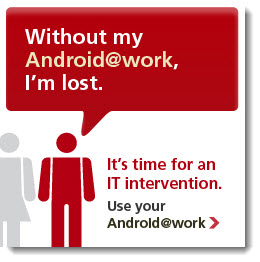If end users want your product, but their IT department makes the purchase decision, can you leverage that demand to drive IT sales leads? That was the question contemplated by the marketing team at MobileIron, a leading provider of mobile device management technology.
MobileIron’s software solution is a prime enabler of so-called Bring Your Own Device (BYOD) initiatives, a fast-growing phenomenon of corporate workers bringing their own mobile computing devices – notably smartphones and tablets – to the workplace in order to connect to the corporate network.
BYOD is a marketing conundrum for vendors like MobileIron: end-users want the flexibility to use their personal devices, but enabling that network access makes the IT department nervous because it opens the door to all sorts of security risks (risks addressed by a solution like MobileIron.) Therefore, IT’s interest in implementing a BYOD initiative can lag behind the interest of their constituent users. Furthermore, IT workers may be familiar with BYOD as a topic, whereas end users may simply be frustrated and unaware of any potential solution.
MobileIron wondered if it might be possible to market BYOD to the mobile end user, and then somehow convert that interest into qualified IT opportunities. They turned to their demand generation agency, Spear Marketing Group, for ideas and asked Spear to develop a pilot campaign that would test the efficacy of marketing MobileIron’s solution to the end user audience.
 Spear developed a multi-step demand generation program that combined online text and display advertising, mobile landing pages, social sharing, and automated email response powered by Marketo, MobileIron’s marketing automation platform. Here’s how the campaign worked:
Spear developed a multi-step demand generation program that combined online text and display advertising, mobile landing pages, social sharing, and automated email response powered by Marketo, MobileIron’s marketing automation platform. Here’s how the campaign worked:
1. Spear created both text and display ads (see image at right) to run on mobile advertising networks targeting the two largest constituencies of mobile workers, those that use iPhones and Android devices. Ads were developed that would specifically reference the reader’s device by name (iPhone or Android) to better connect with the end user “pain” of not being allowed to use that device at work.
2. Upon clicking on the ad, the mobile user was taken to a Marketo-hosted mobile landing page (see image below) that asked for the user’s email address so he/she could be sent information about BYOD that could be subsequently forwarded to colleagues in IT.
3. If the end user forwarded the email to IT, and that individual subsequently clicked on the email, the IT worker was directed to a custom Web microsite that offered an information kit on BYOD and how to implement an initiative within his or her organization.
 “The element that made this campaign so different was the degree to which we put the end user in control of the campaign,” commented Gilda Raczkowski, Spear’s Creative Director. “Typically an ad campaign succeeds when it generates a single response. Here we had to generate that initial response, motivate the responder to forward an email, and then persuade the person on the receiving end of that email to respond also.”
“The element that made this campaign so different was the degree to which we put the end user in control of the campaign,” commented Gilda Raczkowski, Spear’s Creative Director. “Typically an ad campaign succeeds when it generates a single response. Here we had to generate that initial response, motivate the responder to forward an email, and then persuade the person on the receiving end of that email to respond also.”
In the end, results from the pilot campaign exceeded all expectations. Click-through rates from the online ads were all at or above industry averages. Interestingly, display ads performed better than text ads by more than 150 percent, and Android users responded better than iPhone users by a similar margin. Better still, 5 percent of click-throughs resulted in those end users entering their personal email address, and almost 7 percent of end user “leads” resulted in inquiries from qualified IT contacts.
MobileIron feels the concept of marketing an IT solution to end users has been validated. “Our sales cycle can be months long, so we won’t know true ROI from the campaign for a while,” says Adam Stein, MobileIron’s Marketing Director. “However, the campaign has already generated one pipeline opportunity, and we expect more to develop over the coming weeks.”
Spear credits the success of the campaign to a simple, compelling creative concept that resonated with the end user’s pain, and an offer-oriented strategy that marketed the value of information about BYOD, rather than attempting to sell the MobileIron product too early in the sales cycle. “We think the campaign has much more potential,” says Raczkowski. “There were test cells that performed far better than others, and with further testing we think we can drive click-through, conversion rates, and ROI even higher.”
